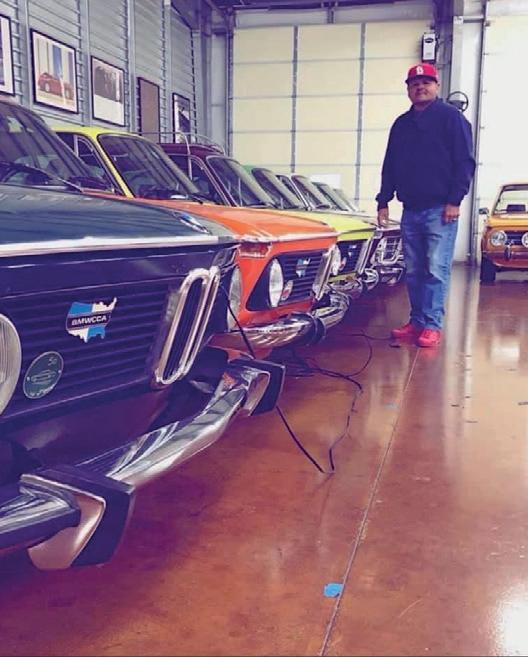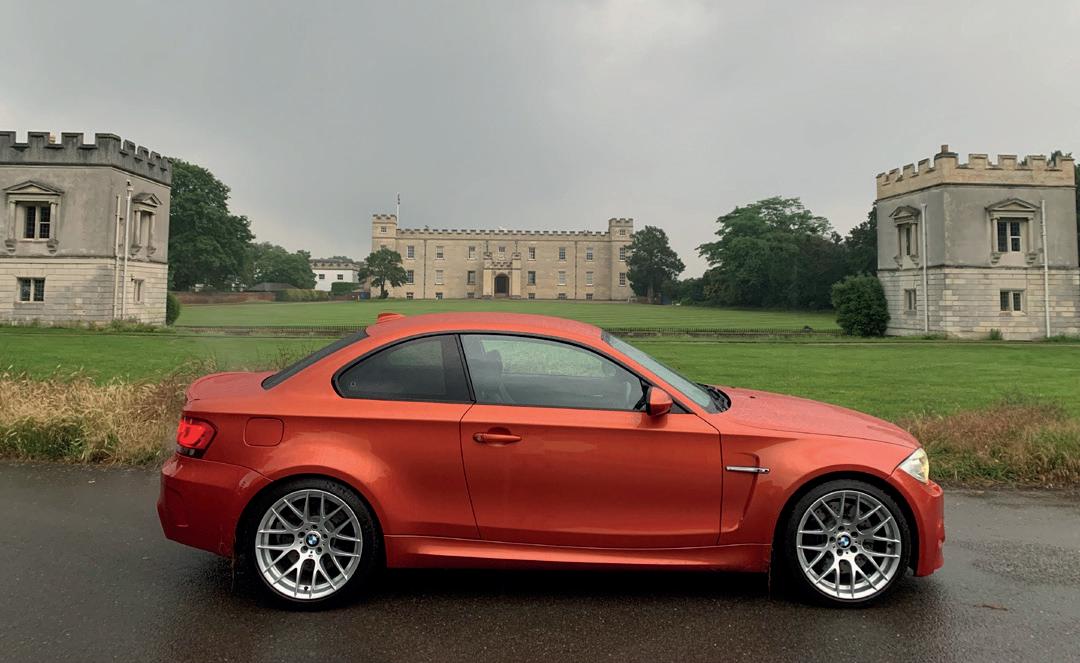
11 minute read
E10 Away
E10 Away
Words by Will Beaumont Photos: BMW Press
Advertisement
Everything you need to know about the UK’s new ethanol-rich petrol, what it can do to your car and how to combat the effects.
Forgive us. Like some conspiracy theorist agitator, we may have added to the panic around the latest crisis. No, we’ve not called into question vaccines or masks, but in the last issue of Straight Six the editor, Jeff, looked back at the destructive fuelgenerated pandemic that affected BMWs (and a few other cars) in the 1990s, the Nikasil issue. Was that feature poor timing, or perfect timing? Because we either caused a stir or sharpened your wits about what could be another fuel disaster, for a small group of cars anyway. A new type of petrol, E10, was introduced at the start of September and it’s not suitable for every car. That means, right now, we’re in the warning stages of this potential disaster.
Most of what you read about E10 boils down to this: check the government website (www.gov.uk/check-vehicle-e10petrol) and see if your car can run on this new fuel. If it’s okay to use, don’t worry. If the petrol is unsuitable, use premium unleaded and your car will be fine. I don’t know about you, though, but such vagueness, such basic simplicity, creates even more questions. What exactly is E10 fuel? Why is it being introduced? Is it damaging to all cars, just less harmful to newer ones that issues are only ever minor? And, importantly, how can we avoid any damage to our precious cars?
To get to the bottom of what the change to E10 fuel really means, and to get a detailed understanding of the situation, we’ve spoken to the technical



departments of both Millers Oils and Castrol Classic Oils.
So, firstly, a simple one, what exactly is E10 fuel? “E10 fuel contains 10% ethanol, which is derived from biomass such as grains or sugar. Until 1st September 2021, standard 95ron E5labelled petrol contained 5% ethanol. This has now been increased to E10 which has 10% ethanol. Higher octane super unleaded has remained at E5” the team at Castrol Classic tells us. It should also be added that diesel is not affected by these new regulations at all.
The reason for the change is for environmental considerations, the Castrol Classic experts go into further detail: “By increasing the proportion of ethanol in petrol, less oil needs to be extracted in the first place. The idea behind using ethanol is that it can be distilled from biological resources such as grains, sugar and even waste wood. As these can be grown, and in a relatively short space of time compared to how long oil takes to form, they are considered to be a renewable energy source. Ethanol production also has a lower CO2 footprint than oil production. The government estimates that the introduction of E10 petrol will lead to a reduction in carbon dioxide emissions of 750,000 tonnes per year, the equivalent to removing 350,000 cars from the road.” The Millers team adds: “It reduces tailpipe emissions, and crops planted for the production of ethanol will over time absorb CO2 from the atmosphere.”
The planting of crops for fuel rather than food, however, does generate some issues, as the Castrol Classic guys touch on: “This one is contentious, there is an argument that growing crops for energy use is not the best use of farmland. In particular, a large amount of land and water is needed to produce a small amount of ethanol distillate. Further, ethanol is often produced from primary food crops; in the US, for example, it is commonly produced from corn. This can distort prices in basic commodity markets and encourage less developed nations to move production focus from food to what can now be considered a cash crop.”
It’s not all bad, there are further benefits to ethanol supplemented fuel according to the Millers team: “It reduces engine knock and increases an engine’s performance.” But also: “Ethanol is less energy-dense and could reduce an engine’s efficiency, therefore lower MPG figures of approximately 1%.”
It’s the actual harm it can do to cars that we need to really discuss. We wouldn’t need this feature if E10 didn’t cause problems for vehicles. So what does ethanol-rich fuel do to a car? “Some older vehicles have components in the fuel system that have never been designed to be used with fuels containing ethanol,” says the Millers technical team. While the Castrol Classic bunch add: “The main issue with ethanol in petrol is moisture and the knock-on effects of acidity. Firstly, ethanol is hygroscopic, so it attracts moisture from the air. Water will mix with ethanol, but not with petrol. Water drops to the bottom of the fuel tank, taking some of the ethanol with it. This is known as partial phase separation. With enough water, the ethanol in the fuel will become saturated and drop out of suspension completely.”
That doesn’t sound great, but it doesn’t sound like E10 is the fuel-systemdestroying petrol that’s been suggested. Hang on, the technical squad at Castrol Classic have more to add: “A further issue is that ethanol-mix fuels can become acidic. Ethanol fuels are not acidic when they come out of the fuel pump. However, acidity can be caused by a reaction to CO2.
CO2 is extremely soluble in ethanol, so, like moisture, it will be attracted to an ethanol fuel blend from the atmosphere. And, in the presence of water, it will convert to carbonic acid. It will effectively





become rainwater, which is mildly acidic at pH 5.6.
“When the pH of ethanol drops below 6.5, it can cause fuel pumps to malfunction due to a film forming between the brushes and commutator, fuel injectors can fail from corrosion or carburettor floats to stick.
“The most safety-critical thing to check is your fuel hoses. Older hoses were made of more permeable materials, which allow more vapour to escape the hose wall than modern materials do. When the petrol contains ethanol, the ethanol in the vapour will dry out the hose, causing it to become brittle and prone to cracking. Then there are other areas where corrosion may occur that will not necessarily give a visual indication, such as the base of the fuel tank.
“One other thing to look out for is hot-running. Ethanol actually burns at a lower temperature than petrol. If you look at the molecular structures of petrol and ethanol, you will see a major difference: ethanol contains an oxygen atom, whereas petrol is oxygen-free. When the ethanol petrol blend is combusted in the engine, the oxygen supplied by ethanol – that would not be there in pure petrol – is now added. This causes the fuel-air mixture to become leaner and can result in hot running. However, it can be resolved by setting your fuel mixture slightly richer.”
“Finally, it can even cause excessive cylinder wear.” Is this Nikasil all over again? No, don’t worry. “All vehicles from 2011 are required to be E10 or even higher percentage ethanol fuels compatible” the Millers Oils technical crew reassures us.
“Vehicle and component manufacturers have been aware of ethanol requirements in petrol for several years, and indeed ethanol-blend petrol has been commonplace in some other countries for a long time. Most vehicles from 2002 onwards are compatible with E10” the Castrol Classic experts explain. “BMW, in particular, has stated that all of their cars can use E10 petrol, so they’re confident that there won’t be any issues with running and that fuel system components will be made of compatible materials.”
For older cars, it’s a different story according to the masters at Castrol Classic: “The issue for owners of classics is that these vehicles are often only used occasionally or laid-up over the winter period. As the fuel is sitting in the tank for a longer period of time, the hygroscopic action of E10 fuel is exacerbated, potentially leading to more serious corrosion problems in the fuel tank and lines. After sitting for so long, the petrol can also become stale making the engine run badly.”
The new E10 fuel, then, is mostly only a problem for older cars. But if you’re still not wholly satisfied with BMW saying all of its cars are compatible with ethanolsupplement fuels (because clearly, it isn’t taking into account the classic cars from its past) and what the government website says, and you want to do your own checks to see if it’s safe to use E10 in your car, the Castrol team has a few tips on what to look for: “The first place to check is your owner’s manual. Also, your fuel hoses should have their specification stamped on them. An R6-type hose was the original fitment on older vehicles, but the generally accepted standard nowadays for use with an ethanol blend is rated R9. Check and replace if necessary or damaged, and any hoses that look original on a car from before 2000, or around then, should be considered for replacement as a matter of course.”
If you’ve concluded your fuel system won’t be happy with E10 in it, the repercussions of accidentally filling the tank aren’t serious. “Filling up with a tank of E10 should not cause any immediate damage and it will still run the engine. Ethanol corrosion to seals, plastics and metals will happen over time.” Says the Miller Oils specialists. The Castrol whizzes suggest not to panic: “The best thing to do is to drive the vehicle until the fuel tank is almost empty, then refill with suitable petrol, and do this as soon as possible. The potentially damaging effects of E10 will only occur with the introduction of moisture to the fuel, so as long as the vehicle isn’t sitting around for a long period of time you shouldn’t


have any problems.” Get out and drive, our favourite advice. We can hear you all now: “Sorry love, I think I filled the tank with that E10 stuff again. I’ve got to go out for another drive to use it all up. I can’t help it, it’s what the experts have recommended.”
If you’ve got a car from this century that you use a lot, hopefully, you’ll be a lot more comfortable with E10. There really is nothing for you to worry about. For classic owners, or for cars that aren’t used frequently, it’s not so rosy. The default solution, use premium fuel which remains at just 5% ethanol, isn’t the magic answer you might hope for: “The issues previously mentioned regarding potentially damaging effects to fuel lines in particular, and other components generally, should still give the classic driver cause for concern. Even at the lower 5% ethanol content of E5, there is still ethanol in the fuel, albeit at a lesser concentration.” Says the Castrol Classic team, adding: “Still, we would normally recommend running classic vehicles on super unleaded anyway, as the higher octane will be beneficial to performance.”
For classics and cars that only come out in the summer, the best way to counter the negative effects of ethanolblend fuels, whether it’s E5 or E10, is an additive. “Petrol additives are designed to counter the harmful effects that modern fuels can have on components in older vehicles. By using an additive that stabilises the ethanol, you mitigate the risk of damage” the aces at Castrol Classic say.
What’s the best thing to do, regardless of cost? What if you want the ultimate protection? You care for your car, service it regularly, treat it to all sorts of cleaning potions; you want to use the best thing in the fuel tank too. The Millers Oils team says: “The ideal situation would be E10 fuel treated with EPS and Petrol Power Ecomax.” Its own set of additives. “When EPS is used, it will negate the harmful effects of ethanol corrosion. So, essentially, using an additive will be far more cost-effective pence-per-litre than using a super unleaded fuel, which would still contain a percentage ethanol.”
The team at Castrol Classic’s opinion is slightly different, with a preference for their own products, naturally: “Super unleaded with Classic Valvemaster Plus will give you optimum performance alongside optimum protection. It is suitable for all vehicles that do not have a catalytic converter and, as well as stabilising ethanol, it will provide protection against valve seat recession, improve fuel economy and performance, keep your fuel system clean, and prevent corrosion. Valvemaster Plus also gives an increase in fuel economy that will counteract the effect of E10.”
The ideal solution, as ever, requires more money to be spent. It looks like a fuel additive can be added to the long list of car care products we already fork out for. In fact, because we’ve been using E5 petrol for years, something to counter the detrimental effects of ethanol in our tanks should have been there alongside battery conditioners, car covers and tyre savers, items we’ve lavished on our cars happily, a while ago. If there’s one benefit to the introduction of E10, it’s that it has highlighted just what a nuisance ethanol is in classic and modern cars that are used only occasionally. Thankfully there’s a solution in these additives. Yes, it involves spending money. And no, it’s hardly as sexy as new wheels, hot cams or racy suspension, but if there’s one thing we’re expert at, it’s spending cash on our cars.












